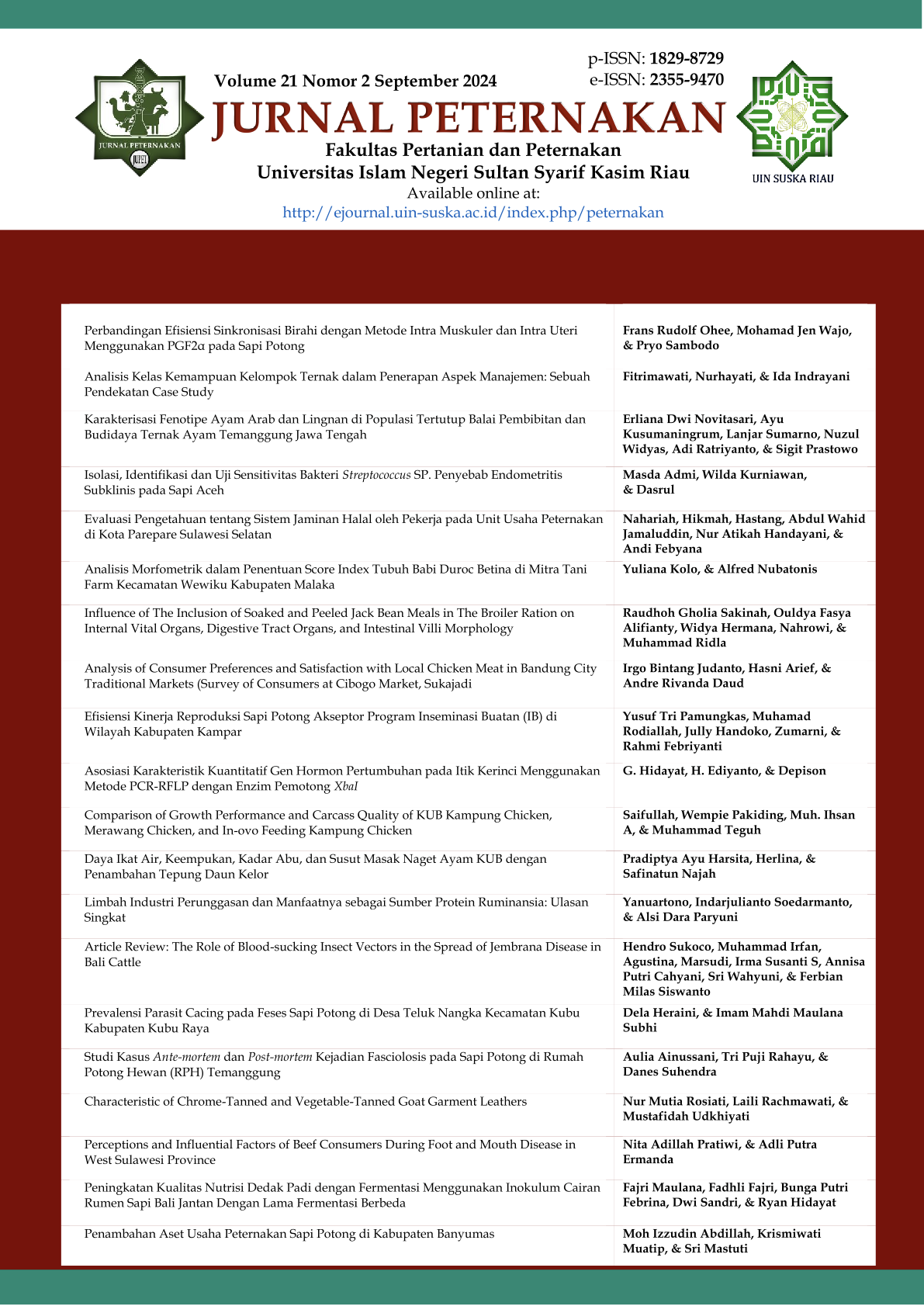Perceptions and Influential Factors of Beef Consumers During Foot and Mouth Disease in West Sulawesi Province
DOI:
https://doi.org/10.24014/jupet.v21i2.29617Keywords:
Perceptions, influential factor, beef, foot and mouth diseaseAbstract
ABSTRACT. This study aims to determine the response of customer perceptions and factors that influence consumer decisions to buy and consume beef during the foot and mouth disease epidemic that affected cattle in 2022. The variables used in this study consist of several aspects that are thought to influence consumer perceptions, such as product aspects, nutrition and health aspects, knowledge aspects, and product handling aspects, as well as sociodemographic conditions of housewife such as education level, employment status, and location of the area of household, which are used as variables to determine consumer determinants, and 100 housewife data was collected as a sample for this research. The study's findings revealed a significant relationship between housewife education and consumers' perceptions of meat consumption during the FMD pandemics, but no significant correlation between housewife occupations (P>0.005) or household location (P>0.005). During FMD pandemics, housewife education has the most influential factor (P<0.005) on consumer perceptions of beef consumption.
References
Akaichi, F., K. Glenk, & C. R. Giha. 2019. Could animal welfare claims and nutritional information boost the demand for organic meat? evidence from non-hypothetical experimental auctions. Journal of Cleaner Production 207:961–70. doi: 10.1016/j.jclepro.2018.10.064.
Badan Pusat Statistik Provinsi Sulawesi Barat. Jumlah Rumah Tangga di Provinsi Sulawesi 2015-2022.
Badan Pusat Statistik. Berita Resmi Statistik No. 84/11/Th. XXV, 15 November 2022 tentang Indeks Pembangunan Manusia (IPM) Tahun 2022.
Ermanda, A. P., Jafrinur, & J. Hellyward. 2020. Influential factors of animal food consumption in West Sumatera Province [Application of almost ideal demand system model]. IOP Conference Series: Earth and Environmental Science 497(1). doi: 10.1088/1755-1315/497/1/012052.
Ermanda, A. P., Jafrinur, & J. Hellyward. 2019. Pola konsumsi pangan hewani pada rumahtangga di Propinsi Sumatera Barat (Penerapan model almost ideal demand system).” Jurnal Peternakan Indonesia (Indonesian Journal of Animal Science) 21(3):220. doi: 10.25077/jpi.21.3.220-229.2019.
Fathurrohman, R. A. N, & D. S. K. Dewi. 2023. Dinamika kebijakan pemerintah Indonesia dalam menangani endemi penyakit mulut dan kuku (PMK) di tahun 2022. Jurnal Ilmu Sosial dan Ilmu Politik (JISIP) 12(3):317–27. doi: 10.33366/jisip.v12i3.2670.
Govindaraj., B. G. Kumar., A. Krishnamohan., R. Hegde., N. Kumar., K. Prabhakaran., V. M. Wadhwan., N. Kakker., T. Lokhande., K. Sharma., A. Kanani., Limaye., K. Natchimuthu K., P. N. Ananth., A. K. De., T. A. Khan., J. Misri., B. B. Dash., B. Pattnaik, & R. Habibur. 2021. Foot and Mouth Disease (FMD) incidence in cattle and buffaloes and its associated farm-level economic costs in endemic India. Preventive Veterinary Medicine 190(August 2020):105318. doi: 10.1016/j.prevetmed.2021.105318.
García-T. S., A. L. Gajardo, & F. J. Mesías. 2016. Intensive vs. free-range organic beef. a preference study through consumer liking and conjoint analysis. Meat Science 114:114–20. doi: 10.1016/j.meatsci.2015.12.019.
Kerth, C. R., A. L. Harbison., S. B. Smith, & R. K. Miller. 2015. Consumer sensory evaluation, fatty acid composition, and shelf-life of ground beef with subcutaneous fat trimmings from different carcass locations. Meat Science 104:30–36. doi: 10.1016/j.meatsci.2015.01.014.
Li, X., K. L. Jensen., C. D. Clark, & D. M. Lambert. 2016. Consumer willingness to pay for beef grown using climate friendly production practices. Food Policy 64:93–106. doi: 10.1016/j.foodpol.2016.09.003.
Nugroho, E. J, & L. Simamora. 2021. Faktor – faktor yang mempengaruhi keputusan pembelian daging sapi di pasar raya I Salatiga. Ziraa’Ah Majalah Ilmiah Pertanian. 46(2):134. doi: 10.31602/zmip.v46i2.4528.
Ogundijo, D. A., A. A. Tas, & B. A. Onarinde. 2022. “Age, an important sociodemographic determinant of factors influencing consumers’ food choices and purchasing habits: An English University Setting.” Frontiers in Nutrition 9(May):1–10. doi: 10.3389/fnut.2022.858593.
Rombach, M., D. Dean., F. Vriesekoop., W. de Koning., L. K. Aguiar., M. Anderson., P. Mongondry., M. O. Gyamfi., B. Urbano., C. A. G. Luciano., W. Hao., E. Eastwick., Z. V. Jiang, & A. Boereboom. 2022. Is cultured meat a promising consumer alternative? exploring key factors determining consumer’s willingness to try, buy and pay a premium for cultured meat. Appetite 179. doi: 10.1016/j.appet.2022.106307.
Rusdiana. S, Ismail., R. Sulaiman., Amiruddin., R. Daud., Zainuddin, & M. Sabri. 2018. The Effort of Beef Needs Supplying for Coming Years in Indonesia. Int. J. Trop. Vet. Biomed. Res. 3(1): 48-59;
Teixeira, A, & S. Rodrigues. 2021. Consumer perceptions towards healthier meat products. Current Opinion in Food Science. 38:147–54. doi: 10.1016/j.cofs.2020.12.004.
Downloads
Published
Issue
Section
License
The Authors submitting a manuscript do so on the understanding that if accepted for publication, copyright of the article shall be assigned to Jurnal Peternakan and published by Fakultas Pertanian dan Peternakan Universitas Islam Negeri Sultan Syarif Kasim Riau as publisher of the journal.
Authors who publish with this journal agree to the following terms:
Authors automatically transfer the copyright to the journal and grant the journal right of first publication with the work simultaneously licensed under a Creative Commons (CC BY) that allows others to share the work with an acknowledgement of the work's authorship and initial publication in this journal.
Authors are able to enter into separate permission for non-exclusive distribution of the journal's published version of the work (e.g., post it to an institutional repository or publish it in a book), with an acknowledgement of its initial publication in this journal.
Authors are permitted and encouraged to post their work online (e.g., in institutional repositories or on their website) prior to and during the submission process, as it can lead to productive exchanges, as well as earlier and greater citation of published work (See The Effect of Open Access).

